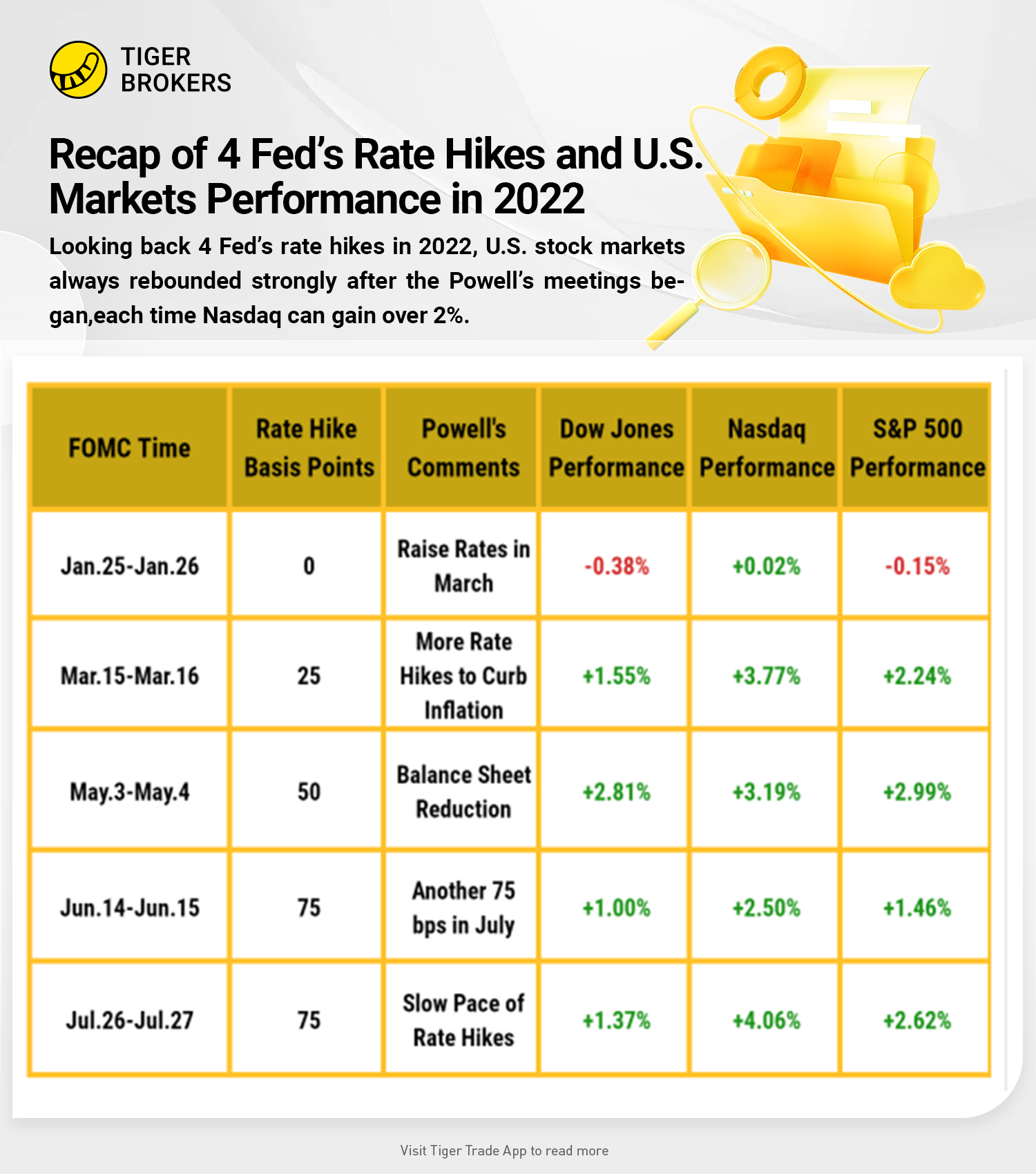Looking back on 4 Fed’s rate hikes in 2022, investors might be surprised at U.S. stock markets’ daily performance after Powell’s meetings began, because U.S. stock indexes can rebound strongly. According to the pictures below, Nasdaq was the biggest winner, which can gain over 2% when the Fed’s meeting took place in March, May, June and July.
Except for the daily performance, let’s have a brief review of Powell’s meetings in 2022
Powell’s Comments: From Raising Rates in March to Slowing Pace of Rate Hikes
In January, the Federal Reserve announced it would hold its benchmark interest rate near zero and maintain its current pace for tapering emergency asset purchases. The purchase program is slated to end in early March, opening the door for the Fed to raise the benchmark rate as early as that month.
On March 16, the Federal Reserve raised rates for the first time since 2018, by a quarter percentage point, or 25 basis points. It said in a statement that the invasion of Ukraine by Russia is causing tremendous human and economic hardship, the implications for the U.S. economy are highly uncertain, but in the near term the invasion and related events are likely to create additional upward pressure on inflation and weigh on economic activity. The Fed added that it anticipates that ongoing increases in the 0.25% to 0.5% target range will be appropriate.
In May, the Federal Reserve raised interest rates Wednesday by half a percentage point and scaled back other pandemic-era economic supports, strengthening its efforts to fight the highest inflation in 40 years and vowing to keep up the pressure as Americans continue to struggle. Except for inflation, Powell added that additional interest rate hikes as high as 0.5 percentage points are “on the table” in the coming months but said policymakers had not seriously discussed even sharper hikes.
In June, the Federal Reserve raised its benchmark interest rate by 75-basis points for the first time since 1994. Powell said another 75 basis-point hike, or a 50 basis-point move, was likely at the next meeting of policy makers. They estimated interest rates would rise even further this year, to 3.4% by December and 3.8% by the end of 2023. That was a big upgrade from the 1.9% and 2.8% that they penciled in for their March projections.
Yesterday, it enacted its second consecutive 0.75 percentage point interest rate increase. Powell said the Fed could hike by 0.75 percentage point again in September, but that it would be dependent on the data. He added, “As the stance of monetary policy tightens further, it likely will become appropriate to slow the pace of increases.”
So how did Wall Street think of the latest meeting? As a whole, they had mixed views, Allianz remained optimistic about slowing the pace of increases while Morgan Stanley stayed pessimistic about the fear of economic recession.
Wall Street’s Mixed Views About the Latest Meeting
“With inflation rising again in June, a 75 basis point hike was certainly warranted, and the Fed has done it,” said Charlie Ripley, senior investment strategist at Allianz Investment Management. “That said, recent economic data is introducing a greater degree of uncertainty around the path of policy as we go from here.”
Art Hogan, chief market strategist at B. Riley Wealth said, “First and foremost, the market got very much what they expected in terms of the rate hike, that’s a sigh of relief. The second is, that Jerome Powell and the FOMC are really walking away from forwarding guidance. That’s something that he wanted to do for a year and now it appears as though they’re not going to stick their neck out and try to let us know the order of magnitude of the next rate hike. As a matter of fact, he leaned into the fact that, at some point in time, the size of the rate increases likely would go down -- that comment in and of itself felt like the money ball.”
However, Morgan Stanley analyst Mike Wilson said Wall Street’s excitement over the idea that interest rate hikes may slow sooner than expected is premature and problematic.“The market always rallies once the Fed stops hiking until the recession begins. …it’s unlikely there’s going to be much of a gap this time between the end of the Fed hiking campaign and the recession,″ he said. “Ultimately, this will be a trap.”
Jimmy Chang, chief investment officer at Rockefeller Global Family Office said, “The only messaging here, if there’s any slight pivot, is that they open with the line, recent indicators of spending and productions have softened. So it’s kind of acknowledging they’re seeing some softness, but they quickly follow that with nonetheless job gains have been robust. So again, to me, that’s the message that what they’re focused on is the job market. That the job market really has to deteriorate materially for them to pivot.”

Comments